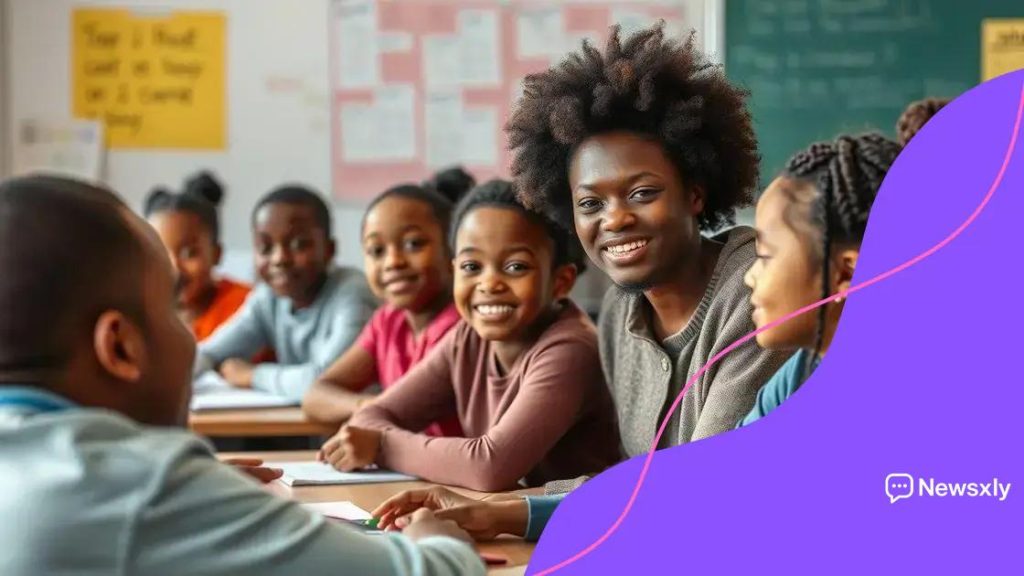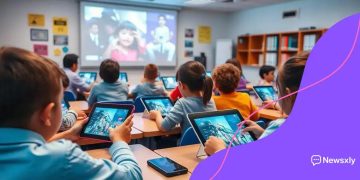Support systems for students with learning disabilities

Support systems for students with learning disabilities include individualized education programs, positive reinforcement, technology tools, and effective communication between educators and parents, all crucial for fostering an inclusive and successful learning environment.
Support systems for students with learning disabilities play a significant role in helping them succeed academically. Have you ever wondered how to create an inclusive environment for them? This article dives into essential strategies and resources to pave the way for these students.
Understanding learning disabilities
Understanding learning disabilities is vital for creating effective support systems. These disabilities can affect how students learn, process information, and interact with others. By recognizing and addressing these challenges, educators and caregivers can help students thrive.
What Are Learning Disabilities?
Learning disabilities are neurological disorders that impact a person’s ability to read, write, or do math. They are often linked to problems with brain processing. It’s important to note that these disabilities do not reflect the student’s intelligence.
Common Types of Learning Disabilities
- Dyslexia: Difficulty with reading due to problems identifying speech sounds.
- Dyscalculia: Challenges with math concepts and numbers.
- Dysgraphia: Difficulty with writing, which can affect handwriting and spelling.
- Processing Disorders: Trouble processing language or visual information.
These conditions can co-occur, making it essential to understand each student’s unique needs. Creating a supportive environment is critical, where teachers utilize various teaching methods to address different learning styles.
Encouragement and understanding from parents and educators can significantly impact students with learning disabilities. For instance, using visual aids, interactive activities, and personalized instructions can improve learning outcomes. Students often benefit from accommodations like extra time on tests or the use of technology. The goal is to foster a sense of confidence and competence.
Why Awareness Matters
Awareness of learning disabilities helps dispel myths and promotes empathy among peers. By understanding their classmates’ challenges, students can develop supportive relationships, fostering an inclusive classroom atmosphere. Awareness also empowers parents to seek resources and advocate for their children’s needs.
In summary, comprehending the complexities of learning disabilities enables us to provide better support. When we understand these challenges, we can create tailored strategies that enhance learning and promote success for every student.
Key support systems for students
Key support systems for students with learning disabilities are essential for their academic success. These systems provide necessary resources and accommodations to help students overcome challenges and develop their strengths.
Types of Support Systems
Support systems can include various methods and resources tailored to meet individual student needs. Schools often implement strategies that promote understanding and integration for these students.
- Individualized Education Programs (IEPs): Customized plans that outline specific learning goals and services.
- Special Education Services: Dedicated resources and professionals who focus on meeting diverse educational needs.
- Accommodations and Modifications: Adjustments in teaching methods and assessments to help students access the curriculum.
- Support Groups: Peer and parental support networks that provide encouragement and share resources.
Having access to these support systems can make a significant difference. Teachers and parents working together is crucial. When they collaborate, students are more likely to receive the personalized attention necessary for success.
Utilizing technology is another powerful method to aid students. Tools like speech-to-text software, audiobooks, and interactive learning apps can help students engage with content in ways that suit their learning styles.
Role of Teachers and Educators
Teachers play a vital role in implementing support systems for students with learning disabilities. By understanding individual needs and being proactive, teachers can create an inclusive classroom environment. This includes using varied teaching strategies, such as visual aids or hands-on activities, to accommodate different learning preferences.
Additionally, fostering a positive classroom culture that promotes acceptance and empathy among peers is important. When students understand and support one another, it helps those with learning disabilities feel more included.
In summary, key support systems for students with learning disabilities encompass IEPs, special education services, accommodations, and the cooperation of teachers and families. Empowering students through these resources is essential to help them achieve their full potential.
Strategies for educators and parents

Strategies for educators and parents play a crucial role in supporting students with learning disabilities. When both groups work together, they can create an environment that fosters growth and confidence. Simple yet effective techniques can significantly impact a child’s educational journey.
Effective Communication
Open communication is vital between parents and teachers. They should share information about a child’s progress and challenges regularly. Using clear and positive language can help build a strong partnership, making it easier to address needs promptly.
Utilizing Individualized Approaches
Each student with a learning disability has unique strengths and weaknesses. Educators should tailor their teaching methods to fit individual learning styles. This could involve adapting lessons to include visual aids, hands-on activities, or technology tools that resonate with the student.
- Multisensory Learning: Engage multiple senses to reinforce concepts. For example, use visual presentations alongside hands-on projects.
- Goal Setting: Work with students to set achievable goals. Celebrate small successes to boost confidence and motivation.
- Regular Feedback: Provide constructive feedback regularly. This helps students understand their progress and areas for improvement.
It’s important that parents reinforce learning at home. Reading together, practicing skills, and encouraging learning in a fun way can make a big difference. Additionally, creating a consistent routine can help maintain structure and support a student’s learning needs.
Encouraging Independence
Encouraging students to take responsibility for their learning fosters independence. Parents and educators can guide them in developing self-advocacy skills. Teaching children to express their needs and ask for help builds confidence and ownership over their education.
Collaboration between parents and teachers is essential in making adjustments and refining strategies. Regular meetings and check-ins create a team approach to education. This collaboration ensures that all parties are aware of the student’s challenges and successes, leading to more focused support.
In conclusion, effective strategies for educators and parents involve communication, individualized approaches, and fostering independence. Together, they can create a strong support system that enhances learning for students with learning disabilities.
Technology tools to aid learning
Technology tools to aid learning have become essential for students, especially those with learning disabilities. These tools can enhance understanding, improve engagement, and cater to different learning styles. Implementing the right technology can create a more inclusive education environment.
Types of Technology Tools
Many technology tools are available today, each offering unique features that can assist students. These tools can range from software applications to hardware devices, all designed to make learning easier and more accessible.
- Text-to-Speech Software: This tool reads aloud written content, helping students who struggle with reading.
- Speech-to-Text Programs: Dictation software allows students to speak into a microphone to generate text, aiding those with writing difficulties.
- Organizational Apps: Tools like calendars and task lists help students manage their time and assignments effectively.
- Interactive Learning Platforms: Websites and apps that offer educational games encourage engagement through interactive content.
Using these tools can help students with learning disabilities present their work in new formats. For instance, a student may use video presentations to express their understanding of a topic better than through traditional essays.
Benefits of Technology in Learning
Technology in education promotes personalized learning. Customizable tools allow students to work at their own pace, providing a more tailored approach. This adaptability can help reduce frustration and increase motivation.
Additionally, technology connects students to a broader range of resources. Online libraries, research databases, and educational videos offer diverse materials that can cater to various interests and learning preferences.
It’s essential for educators and parents to guide students in using these tools effectively. Providing training on how to utilize technology ensures that students maximize their learning potential while developing important skills.
Incorporating technology tools not only aids students academically but can also foster collaboration. Online discussion platforms allow students to engage in group work from different locations, promoting teamwork and communication.
Building a supportive classroom environment
Building a supportive classroom environment is essential for the success of students with learning disabilities. A positive classroom culture promotes learning, empathy, and cooperation. Educators play a key role in creating this environment through specific strategies and actions.
Creating an Inclusive Atmosphere
Inclusion is the foundation of a supportive classroom. Students should feel valued and understood, regardless of their challenges. By promoting respect among classmates, teachers can create a safe space for all learners.
- Encourage Teamwork: Group activities help build relationships and foster a sense of belonging.
- Celebrate Diversity: Recognize and celebrate the unique strengths each student brings to the classroom.
- Create Clear Expectations: Establishing rules helps students understand what is expected, providing a sense of security.
Supportive environments also consider physical aspects, such as classroom layout and accessibility. Having quiet spaces or comfortable seating options can help students with learning disabilities focus better.
Utilizing Positive Reinforcement
Positive reinforcement can significantly impact student behavior and confidence. Praising students for their efforts, not just for their achievements, encourages them to keep trying. Small rewards for reaching goals can motivate students to stay engaged.
Providing constructive feedback is vital to helping students learn and grow. Feedback should highlight areas for improvement while acknowledging their successes. This approach builds self-esteem and a love for learning.
Encouraging students to express their feelings and thoughts also creates a supportive classroom. Allowing them to share their experiences fosters connections and helps teachers understand individual needs better. Regular check-ins can be beneficial in maintaining this open communication.
Involving Parents and Caregivers
Building a supportive classroom environment also involves parents and caregivers. When families are engaged in their child’s education, it strengthens the connection between home and school. Regular updates, parent-teacher meetings, and workshops can keep parents informed and involved in their child’s learning process.
In conclusion, creating a supportive classroom environment requires effort from educators, students, and families. By promoting inclusivity, utilizing positive reinforcement, and involving parents, schools can create a nurturing atmosphere that empowers students with learning disabilities to thrive.
FAQ – Frequently Asked Questions about Support Systems for Students with Learning Disabilities
What are some effective strategies for supporting students with learning disabilities?
Effective strategies include creating an inclusive atmosphere, utilizing positive reinforcement, maintaining open communication, and incorporating technology tools.
How can technology help students with learning disabilities?
Technology can provide personalized learning experiences through tools like text-to-speech software, organizational apps, and interactive learning platforms.
Why is communication between teachers and parents important?
Open communication fosters collaboration, ensuring that both teachers and parents work together to meet the unique needs of the student.
What role does a supportive classroom environment play in learning?
A supportive classroom environment encourages student engagement, builds confidence, and promotes a sense of belonging, which is essential for students with learning disabilities.





